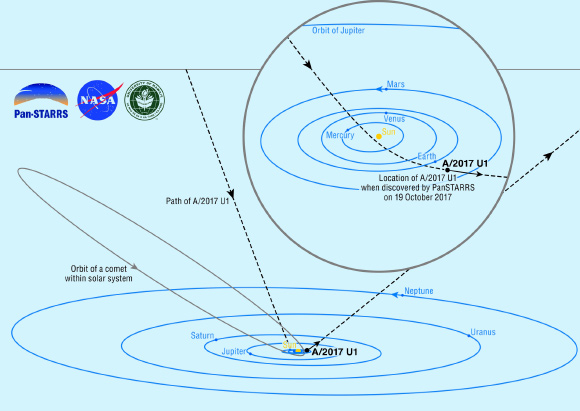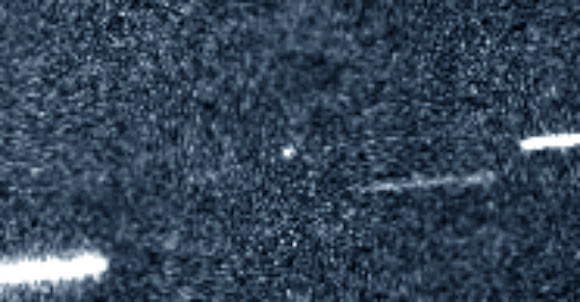For the first time, astronomers think they’ve spotted an asteroid (or perhaps a comet) in the Solar System that came from interstellar space.
A/2017 U1 — which initially some believed to be a comet, but is now believed to be an asteroid — is approximately 1,300 feet (400 m) in diameter.
The object was discovered on October 19, 2017, by Pan-STARRS 1 telescope on Haleakala, Hawaii.
According to the astronomers, A/2017 U1 came from the direction of the constellation Lyra, cruising through interstellar space at a brisk clip of 15.8 miles per second (25.5 km per second).
The small body approached our Solar System from almost directly ‘above’ the ecliptic, the approximate plane in space where the planets and most asteroids orbit the Sun, so it did not have any close encounters with the eight major planets during its plunge toward the Sun.
On September 2, it crossed under the ecliptic plane just inside of Mercury’s orbit and then made its closest approach to the Sun on September 9.
Pulled by the Sun’s gravity, A/2017 U1 made a hairpin turn under the Solar System, passing under Earth’s orbit on October 14 at a distance of about 15 million miles (24 million km).
It has now shot back up above the plane of the planets and, traveling at 27 miles per second (44 km per second) with respect to the Sun, the object is speeding toward the constellation Pegasus.

This schematic diagram of our Solar System shows the dramatic path of A/2017 U1 (dashed line) as it crossed the plane of the planets (known as the ecliptic), and then turned and headed back out. The inset shows the object’s path through the inner Solar System, with the short solid segment showing the small two-week-long portion of the path during which the object can be observed by large telescopes. For comparison, the highly elongated orbit of a comet, which is part of our Solar System, is also depicted. Image credit: Brooks Bays / SOEST Publication Services / University of Hawaii Institute for Astronomy.
“Its motion could not be explained using either a normal solar system asteroid or comet orbit,” said Dr. Rob Weryk, an astronomer at the University of Hawaii Institute for Astronomy who was the first to spot A/2017 U1.
“This is the most extreme orbit I have ever seen. It is going extremely fast and on such a trajectory that we can say with confidence that this object is on its way out of the Solar System and not coming back,” said Dr. Davide Farnocchia, a scientist at the Center for Near-Earth Object Studies (CNEOS) at NASA’s Jet Propulsion Laboratory.
“We have been waiting for this day for decades. It’s long been theorized that such objects exist — asteroids or comets moving around between the stars and occasionally passing through our Solar System — but this is the first such detection. So far, everything indicates this is likely an interstellar object, but more data would help to confirm it,” said Dr. Paul Chodas, CNEOS manager.
“This kind of discovery demonstrates the great scientific value of continual wide-field surveys of the sky, coupled with intensive follow-up observations, to find things we wouldn’t otherwise know are there,” said Dr. Matt Holman, Director of the Minor Planet Center.
“We have long suspected that these objects should exist, because during the process of planet formation a lot of material should be ejected from planetary systems. What’s most surprising is that we’ve never seen interstellar objects pass through before,” said Dr. Karen Meech, an astronomer at the University of Hawaii Institute for Astronomy.
“Further observations of this object are very much desired,” said Dr. Gareth Williams, Associate Director of the Minor Planet Center.
“If they confirm the unusual nature of its orbit, this object may be the first clear case of an interstellar asteroid (comet).”
The discovery was announced this week in the Minor Planet Electronic Circular.
_____
Gareth V. Williams et al. A/2017 U1. MPEC 2017-U183
Gareth V. Williams et al. Comet C/2017 U1 (PANSTARRS). MPEC 2017-U181








